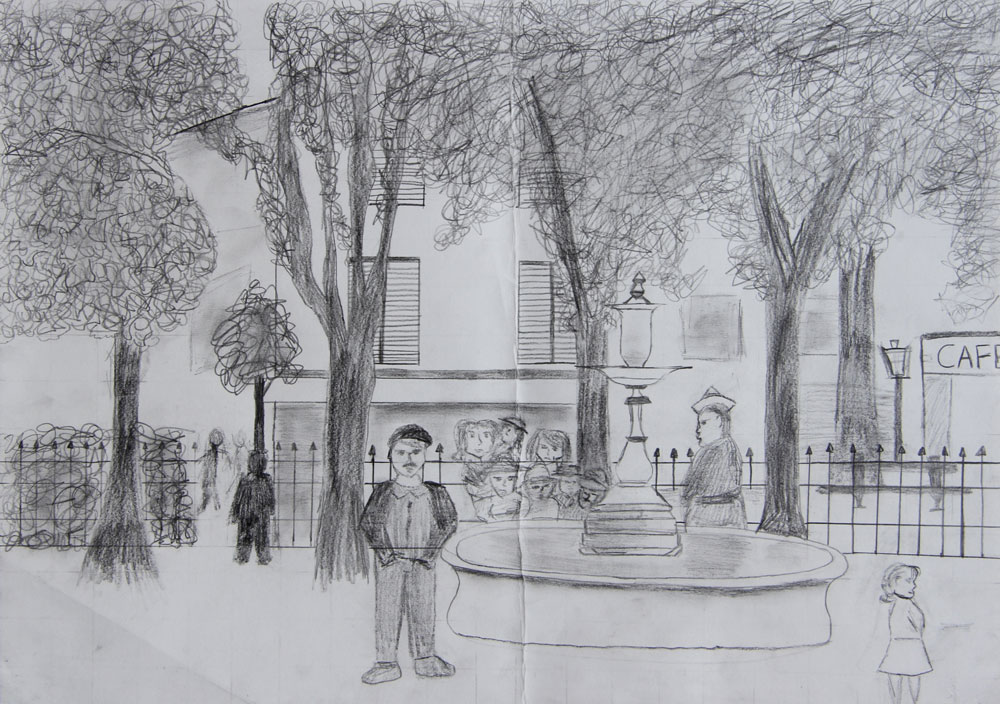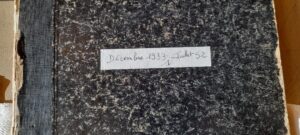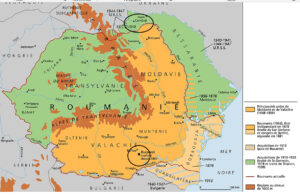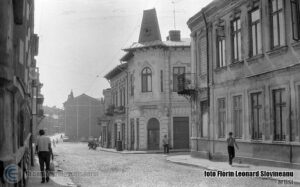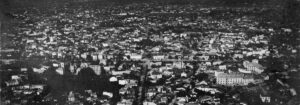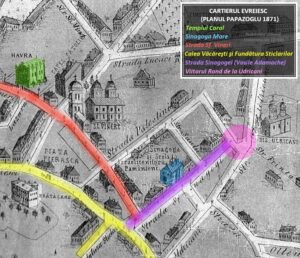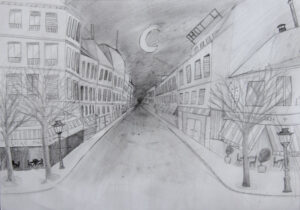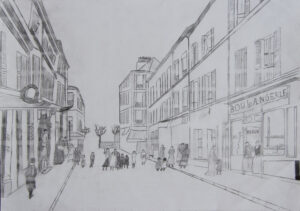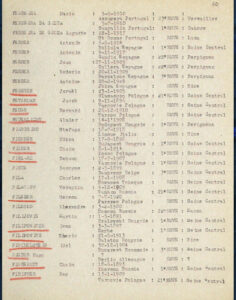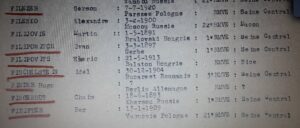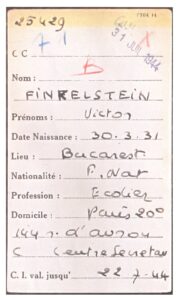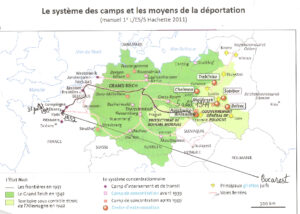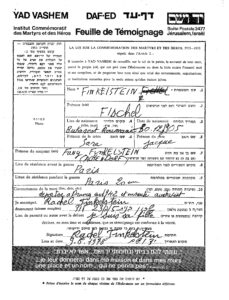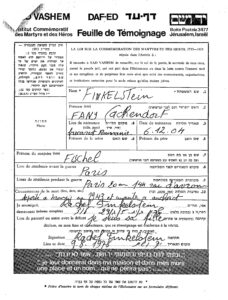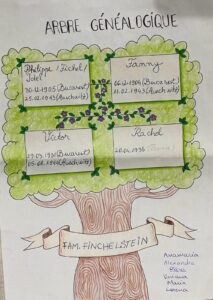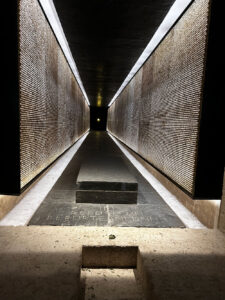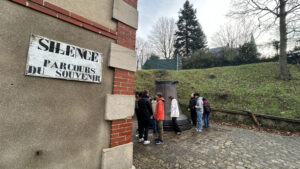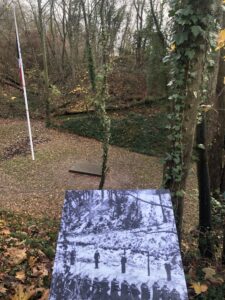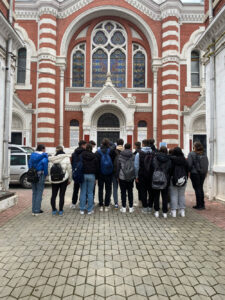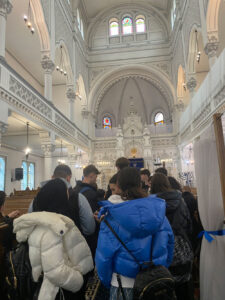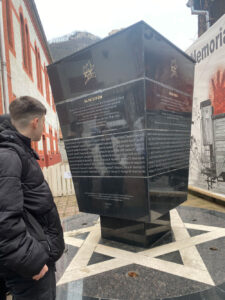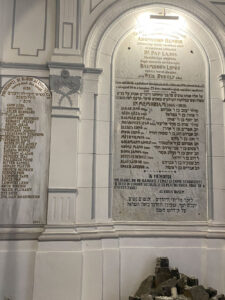Victor FINKELSTEIN
Cover image drawn by Kenza
Introduction to the project and to the two classes involved
I, Sumer Elena Nicoleta, a French teacher at the “Andrei Bârseanu” National Economic Secondary School in Braşov, Romania, have always been interested in history and the story of the Jewish people.
It all began at a meeting during which a group of French as a Foreign Language teachers was introduced to the Convoy 77 European project.
In Romania, the Holocaust is covered in school, and because I personally was keen to breathe new life into my French classes, I jumped at the chance to participate in the project, tentatively at first. However, as my students and I began researching, talking in French and working on little Victor and his family, using the material we’d been given, I realized the impact it was having on them and, of course, the progress they were making in French. The few words they wrote at the end of the project reflect this.
I was also invited and honored to work with Danielle Artur and her class over the course of the 2023-2024 school year.
The students in Romania: introduction:
We are a class of 24 students, at the National Economic Secondary School, in the city of Braşov, in Romania. We are a lively, open-minded, and imaginative class. Writing little Victor’s biography rounded out what we have been studying throughout the school year, the history of the Holocaust. Visiting the synagogue made us even more aware of past events that must never be forgotten. It was an interesting project, which opened our hearts and minds to the world and to past events that must never be allowed to happen again.
And from the French side:
I, Danielle Artur, have been signing up one of my classes for the Convoy 77 project for some time now, and every year it provides an opportunity not only to explore the past, but also to meet the descendants of Holocaust victims and witnesses. In Romania, education about the Holocaust is now compulsory, and I was asked to work on this project with a fellow teacher from Romania.
For me, since the history of the Holocaust is part of a European history, I believe we need to work together as Europeans. My students in France know very little about Romania, even though it’s a European country whose history is closely linked to our own. Thus we embarked on a partnership with Elena Nicoleta to write the biography of a little Romanian boy about whom we had very little documentation.
This biography and our visits to memorial sites echoed the family histories of some of the students in the class.
The class in France: introduction
In 9th grade, we are studying the Second World War, and what better way to understand the society and events of the period than to write the biography of a young Romanian deportee, Victor Finkelstein! Our 9th grade class B class at the Saint-Germain de Charonne middle school, in the 20th district of Paris, France, along with a class of Romanian high school students from Brașov, had the opportunity to get involved in a memorial project in partnership with Convoy 77 non-profit organization, which is dedicated to the memory of the people who were deported on this particular transport.
With the support of our history teacher, we began our investigation by gathering archived records about Victor (school registers, old photos of his neighborhood, Drancy camp files and testimonial cards). We visited several memorials (Mont-Valérien, the Memorial to the Martyrs of the Deportation and the Shoah Memorial in Paris). Based on this information, we were able to retrace the Romanian boy’s journey from the time he arrived in France to when he was interned on July 22, 1944 and subsequently deported.
Meanwhile, in French class, as part of our Quand l’histoire raconte l’Histoire (When History Tells the Story) program, we studied stories about this tragic period, including Annette Muller’s La petite fille du Vel’ d’Hiv’ (The Little Girl of Vel’ d’Hiv). These helped us to better understand what Victor must have gone through when he was deported.
Once we had written this biography, we decided to embark on a visual arts project based on the concepts of memory and time. We were inspired by the sculptures on the gates of Mont-Valérien, which were produced by various different artists. With this in mind, we decided to undertake a project that would ultimately be shared, with each of us producing part of it. After exploring the possibilities, and bearing in mind that we had not been able to find any images of Victor himself, we settled on the idea of reproducing period images of the neighborhood in Paris where the young Romanian boy lived.
This fascinating and rewarding memorial project enabled us to truly appreciate what young Victor went through, while at the same time putting into practice our individual and collective historical, literary and artistic skills.
Victor Finkelstein, a student from our neighborhood in Paris (written by the French students)
Victor, who lived at 144 rue d’Avron, went to the Eugène Reisz school in the 20th district of Paris, as evidenced by the enrolment register in which his name appears. He went to the Tlemcen school at 9 rue Tlemcen, to the Eugène Reisz school and to the school at 40 rue des Pyrénées.
The Eugène Reisz school register (now the Jean Perrin school)
Our school in Paris is the Collège Saint-Germain de Charonne at 3 rue des prairies, in the 20th district of Paris. Source: Google Maps
The map shows the schools that Victor attended, as listed by the Tlemcen School Association:
The Tlemcen school association list
Plans showing the local schools today
The memorial plaque on the wall of the Eugène de Reisz school
The writer Aharon Appelfeld, who, like Victor, was Romanian, was 7 years old at the start of the war, as he recounts in his biography, Histoire d’Une vie (Story of a Life): “I was 7 years old when the Second World War broke out”. He was around the same age as Victor Finkelstein, who was 8 at the start of the war. However, the Tlemcen school association’s list of students states that he was 13 in 1944, although the war began in 1939. Aharon Appelfeld was born in Chernivtsi (Cernăuți, in Romanian). Victor, on the other hand, was born in Bucharest, the capital of Romania. The Romanian students’ school in Brașov lies between these two places.
Map of Romania showing their places of birth
A Jewish family from Romania
(written by the Romanian students)
Victor’s parents were born in Bucharest.
Bucharest had one of the largest Jewish communities in Eastern Europe between the two world wars. The Jews made up 10% of the population of the Romanian capital. Over the years, it was a very dynamic, well-organized and prosperous community, including lawyers, doctors, architects and merchants. They lived in their own neighborhood in the heart of the capital, with pretty houses with small gardens, synagogues and quiet alleyways. In short, the Jews built up an impressive social and cultural legacy
© Florin Léonard Slovineanu, the Jewish Quarter.
© Dan Dinescu (1976), the Jewish Quarter
1924, the Jewish Quarter. Muzeul de Fotografie.
© The Adevarul newspaper
The Finkelstein family, comprising the parents Philippe (Fishel) and Fanny, and the two children, Victor and Rachel, emigrated to France from Romania.
Our research unearthed no records of little Victor’s schooldays or about the neighborhood in which the family lived. Similarly, there is no record of the parents’ occupations in Romania. Officials at the Braşov synagogue told us that the records had been burned.
We do however have a record kept about the family and the Drancy camp file, in which their address in Paris is listed:
Paris Prefecture record for Fanny Finchelstein
Life in Romania
In Romania in the 1940s, things took a turn for the worse for the Jews: decrees issued against them stripped them of their agricultural property and excluded them from society. Doctors, for example, were no longer allowed to practice. And let us not forget the Pogrom in Iaşi, which took place between June 27 and 30, 1941, and which involved unprecedented levels of violence.
So much happened to the Jews in Romania at that time: they had every reason to leave the country.
Life in France
(drawings by the French students and text by the Romanian students)
Drawings based on period postcards of Victor’s neighborhood, and the streets where he walked and knew so well! Project led by Ana Braga, Art and Design teacher.
Mellina’s drawing
Akain’s drawing
Romy’s drawing
After the French Revolution, France was the first European country to emancipate the Jews. As a result, in 1939, France was home to Europe’s second-largest Jewish community. Nearly half of them were recent refugees from Eastern Europe, who had flocked to France in the belief that they would be safe here. This was perhaps also true of the Finkelstein family, who moved to France from Romania.
However, during the war, disaster struck: the French military police were assigned the task of “hunting down” foreign refugees. Entire families were arrested, thousands of Jews were rounded up and taken to Drancy camp, on the outskirts of Paris, and from there they were deported by train to Auschwitz. In 1942, the Vichy regime sent 41,951 Jews to Poland. Throughout these tragic times, many ordinary French people and resistance organizations helped to hide the Jews and tried to shield them from deportation and extermination. This highlighted the heroism of many French people who resisted the Nazi and collaborationist regime and their anti-Semitic policies.
When he first arrived in France, Idel, the father, worked as a driver. As a foreigner, life would not have been easy. Presumably, his eagerness to integrate into French society and to earn the trust of the French people was what prompted him to enlist as a volunteer in the war from September 1 to June 25, 1940. His name is on the list of foreign volunteers found on the French Ministry of Defense’s “Mémoires des hommes” website. He fought for a country that was not his own, in a war that was not his war. However, this testimony to Idel’s courage and solidarity with the French people was never taken into account, given that he was listed for deportation.
List of foreign volunteers recruited between September 1, 1939 and June 25, 1940,
Source: Mémoire des hommes
The family deported
(written by the French students)
Young Victor’s deportation
Drancy camp record card.
FRAN107-F-9-5743-261690-L
Victor was arrested on July 22, 1944, when the Germans raided six UGIF (Union Générale des Israelites de France, or General Union of French Jews) children’s homes, including the Secrétan center, where Victor was staying at the time. The Drancy camp record card confirms the date on which Victor was arrested and gives the place of arrest as the Secrétan center. The capital B, in red, on the card signifies that Victor was liable to be deported immediately rouge.
Victor was arrested on July 22, 1944. On July 22, 1944, six UGIF centers (including the Secrétan center) were rounded up. The Drancy camp card confirms this date of arrest, and gives Victor’s arrest address as the Secrétan center. The red B on this card indicates that Victor was deported immediately.
The list of students from Tlemcen also mentions “70 avenue Secrétan”, and it was on July 22 the UGIF centers were raided. Victor was thus rounded up on July 22, 1944 and subsequently deported on Convoy 77.
Convoy 77 was the last of the large deportation convoys to leave Drancy bound for the Auschwitz extermination camp. Victor, whose registration number was 25429, was one of 324 children who were deported that day. He was just a schoolboy at the time. As was the case for most of the children, Victor was sent to the gas chambers as soon as he arrived at the camp, and died there at the age of 13. Children and seniors were sent straight to their deaths. Victor, a 13-year-old child, was exterminated, as were millions of other deported children.
Map of the deportation route
The Yad Vashem memorial in Israel keeps testimonial sheets completed by Holocaust victims’ families and friends. These testimonials are intended to honor and commemorate the victims. They help to ensure that the victims are seen as individual human beings, rather than just statistics. To raise awareness, so that the victims will never be forgotten. To make it clear that what happened was a terrible event. And, above all, to “resurrect” the memories of the victims that the Nazis had sought to eradicate forever.
The Drancy records also say that Fany Achendorf, who born in Bucharest, Romania, on December 6, 1904, married Fischel Finkelstein, also born in Bucharest, Romania, on December 30, 1905. He was Sara and Jacques’ son. Fany and Fischel were both taken to Drancy and then deported to Auschwitz, where they died, but at different times (Fany was taken to Drancy in 1943 and Fischel in 1942).
The Shoah Memorial website tells us that Fany and Fischel were Victor’s parents. Fany was deported on Convoy 47, which left Drancy on February 11, 1943, and Fischel on Convoy 22, which left Drancy on August 21, 1942, both bound for Auschwitz. Rachel was the only one of the family who avoided being deported.
Yad Vashem testimonial sheets for Fany Finkelstein and Fischel Finkelstein
Family trees
(drawn by the Romanian students)
Memorial sites
(text and photos by the French students)
Paris
The Mémorial des Martyrs de la Déportation (Memorial to the Deported Martyrs) is dedicated to the people who were deported during the Second World War. It pays tribute to the thousands of people deported to Nazi concentration and extermination camps. It symbolizes the suffering that the deportees had to endure, and reminds us that we must never allow such a tragic event to happen again.
Students’ impressions: “I felt oppressed, we were surrounded by four walls”. “Even though we were in the heart of Paris, we could hear nothing, and see nothing, it was as if we were alone in the world. It was very disturbing”.
It focuses on the suffering that deported people underwent, and its structural design reflects the oppressive atmosphere of the concentration camps, in such a way that visitors are immersed in an environment that reminds them of the suffering and sacrifice of the victims. The memorial’s evocative architecture is designed to encourage contemplation. The symbolism of the bars, narrow doors and plaques commemorating the deportees arouses a sense of horror at the inhumane environment of the concentration camps.
Memorial to the Deported Martyrs © Emma
Mont-Valérien © Léo
At Mont Valérien, the main site where the German army executed resistance fighters and hostages in France during the Second World War, a thousand people were murdered, most of them Communists and Jews.
Memorial bell
The bell in memory of those shot at Mont Valérien bears the names of Joseph and Bernard Kirschen, who were also from Romania. They were held hostage and shot for being both Communists and Jewish.
The memorial trail © Léo
The place where the shooting took place: the clearing at Mont Valérien
.This is one of only three surviving photographs of an execution at Mont-Valérien. Execution of FTP MOI members on February 21, 1944.
Boris Holban, a Romanian, was the founder of the FTP-MOI. Photo of the execution: Clemens Rüther © ECPAD – Association des amis de Franz Stock
© Sirine
The class also visited the Shoah Memorial, where Victor’s name is inscribed on the Wall of Names: Clemens Rüther © ECPAD – Association des amis de Franz Stock.
:
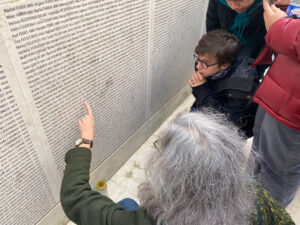

© Inzel
Young Victor’s name is inscribed towards the bottom of the right-hand wall.
In Braşov
(written by the Romanian students)
There is a memorial in Braşov dedicated to local Holocaust victims. There were fewer victims here than in other parts of the country, since they were protected by the authorities, but nevertheless, 240 Jews born in Braşov died and this memorial pays tribute to them.
End of project impressions
(a final note from the Romanian students)
We carried out the project during the 2023-2024 school year; after analyzing the records available to us, working individually or in pairs in class, conducting further research and visiting the Braşov synagogue, the students wrote down their impressions about writing the biography of young Victor. Our small way of paying tribute to him was to lay out our comments in the form of the first letter of his name, V for Victor, who was killed for one reason only: because he was Jewish.


 Français
Français Polski
Polski